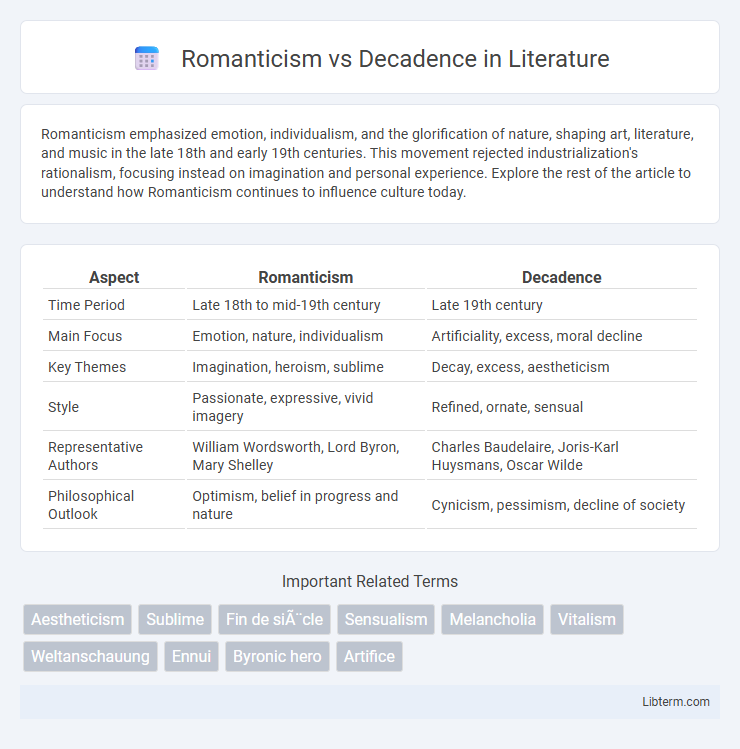Romanticism emphasized emotion, individualism, and the glorification of nature, shaping art, literature, and music in the late 18th and early 19th centuries. This movement rejected industrialization's rationalism, focusing instead on imagination and personal experience. Explore the rest of the article to understand how Romanticism continues to influence culture today.
Table of Comparison
| Aspect | Romanticism | Decadence |
|---|---|---|
| Time Period | Late 18th to mid-19th century | Late 19th century |
| Main Focus | Emotion, nature, individualism | Artificiality, excess, moral decline |
| Key Themes | Imagination, heroism, sublime | Decay, excess, aestheticism |
| Style | Passionate, expressive, vivid imagery | Refined, ornate, sensual |
| Representative Authors | William Wordsworth, Lord Byron, Mary Shelley | Charles Baudelaire, Joris-Karl Huysmans, Oscar Wilde |
| Philosophical Outlook | Optimism, belief in progress and nature | Cynicism, pessimism, decline of society |
Introduction to Romanticism and Decadence
Romanticism emerged in the late 18th century as an artistic and intellectual movement emphasizing emotion, nature, and individualism, reacting against the Industrial Revolution and Enlightenment rationalism. Decadence, which arose in the late 19th century, is characterized by aesthetic excess, moral ambiguity, and a fascination with decline and artificiality, often seen as a reaction to the perceived limitations of Romantic idealism. Both movements deeply influenced literature, art, and culture by exploring different human experiences and values through distinct thematic and stylistic approaches.
Historical Contexts and Origins
Romanticism emerged in the late 18th century as a response to the Enlightenment and Industrial Revolution, emphasizing emotion, nature, and individualism against rationalism and mechanization. Decadence developed in the late 19th century, rooted in Symbolism and fin-de-siecle anxieties, reflecting disillusionment with progress and moral decline in rapidly modernizing societies. These movements embody contrasting cultural reactions to historical transformations in Europe, with Romanticism idealizing natural purity and Decadence exploring aestheticism and existential decay.
Core Philosophies and Ideals
Romanticism emphasizes emotional intensity, individualism, and a deep connection to nature, celebrating imagination and the sublime as paths to transcendent truth. Decadence, in contrast, revels in artifice, aestheticism, and moral ambiguity, often highlighting themes of decline, excess, and sensual indulgence as critiques of societal norms. Both movements challenge Enlightenment rationalism but diverge in their embrace of idealism versus pessimism.
Key Figures in Romanticism
Key figures in Romanticism include William Wordsworth, Samuel Taylor Coleridge, and Lord Byron, who emphasized emotion, nature, and individualism in their works. Their poetry often explored themes of sublime beauty, heroism, and the inner depths of human experience, contrasting with the aestheticism and moral ambiguity found in Decadence. Romanticism's celebration of imagination and spirituality laid the foundation for many literary and artistic movements that followed.
Influential Voices of Decadence
Influential voices of Decadence, such as Charles Baudelaire, Joris-Karl Huysmans, and Oscar Wilde, emphasized themes of artificiality, excess, and aestheticism, challenging the emotional sincerity and nature glorification central to Romanticism. Baudelaire's poetry in "Les Fleurs du mal" explores urban decay and moral ambiguity, contrasting Romantic idealism with modern disillusionment. Huysmans' novel "A rebours" epitomizes Decadent fascination with aesthetic escapism and sensory experience, marking a distinct departure from Romantic emotional breadth.
Artistic Expression and Aesthetic Traits
Romanticism emphasizes emotional intensity, individualism, and a profound connection to nature, characterized by vivid imagery and dramatic compositions that evoke sublime beauty and spiritual depth. Decadence, contrastingly, centers on artificiality, ornate detail, and themes of decay or moral ambiguity, showcasing elaborate aesthetics that highlight sensuality and existential ennui. Both movements use artistic expression to challenge norms, but Romanticism seeks transcendence through idealism while Decadence revels in complexity and disillusionment.
Attitudes Toward Nature and Emotion
Romanticism emphasizes nature as a source of spiritual renewal and awe, celebrating raw emotion as a path to truth and individual freedom. Decadence, however, views nature with a sense of irony or detachment, often highlighting artificiality and emotional excess as expressions of social decadence. The Romantic embrace of sincere emotion contrasts with the Decadent focus on cultivated, sometimes morbid feelings, reflecting differing responses to the natural world and inner experience.
Social Critique and Worldview Differences
Romanticism champions idealism and emotional depth, emphasizing nature, individual freedom, and social reform as responses to industrialization's alienation. Decadence, in contrast, embraces aestheticism, pessimism, and moral decline, critiquing modernity through themes of excess, decay, and existential disillusionment. These movements diverge in worldview: Romanticism envisions progress and redemption, while Decadence reflects skepticism and the erosion of traditional values.
Legacy and Cultural Impact
Romanticism's legacy lies in its profound influence on literature, music, and visual arts, emphasizing emotional depth, individualism, and nature, which shaped 19th-century cultural movements and national identities. Decadence challenged traditional moral values and aesthetics through its embrace of artifice, sensuality, and pessimism, significantly affecting Symbolism, Modernism, and avant-garde movements. Both movements left enduring cultural impacts by redefining artistic expression and inspiring continuous dialogue about creativity, morality, and societal change.
Romanticism vs Decadence: Contemporary Relevance
Romanticism emphasizes emotional depth, individualism, and the sublime in nature, contrasting sharply with Decadence's focus on artificiality, excess, and moral ambiguity. Contemporary cultural trends revive Romantic ideals by valuing authenticity and environmental connection, while Decadence influences modern aesthetics through its embrace of irony and transgressive art. Understanding this dichotomy enriches current debates on creativity, ethics, and identity in an increasingly complex world.
Romanticism Infographic

 libterm.com
libterm.com